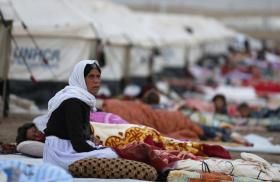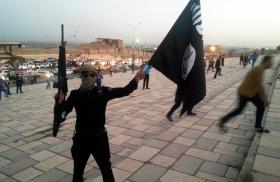
- Policy Analysis
- Counterterrorism Lecture
A Survey of the Near East: Implications for U.S. National Security

Part of a series: Counterterrorism Lecture Series
or see Part 1: U.S. Efforts against Terrorism Financing: A View from the Private Sector
The national intelligence manager for the Near East discusses the post-ISIS 'peace dividend,' the intelligence facets of Syria's humanitarian crisis, the sectarian hurdles to Iraq's reconstruction, and more.
On March 13, The Washington Institute hosted a Policy Forum with David Cattler as part of its long-running Stein Counterterrorism Lecture Series. Cattler serves as National Intelligence Manager for the Near East in the Office of the Director of National Intelligence. The following are his prepared remarks.
Thanks to Matt Levitt for that kind introduction, and to everyone at The Washington Institute for inviting me to speak. WINEP continues to be an indispensable institution at a time when assessing our interests in the Near East could not be more complex or challenging. I am truly grateful for this opportunity, and for your commitment to "Improve the Quality of U.S. Middle East Policy."
As the National Intelligence Manager for the Near East, I share this same goal. I serve as Director of National Intelligence Coats' principal advisor on this critical region. Every day, the "NIM-Near East" team works to ensure that our partners and consumers in the White House and across the interagency have access to the best possible intelligence.
We do this by directly supporting the development and implementation of national policies and strategies. We also integrate the intelligence community—managing and guiding all aspects of the intelligence cycle. This means (1) working with policymakers to identify and articulate their needs; (2) managing and directing collection; (3) assessing the quality of the Intelligence Community's analysis; (4) ensuring that our products—information and assessments—reach consumers, often at "the speed of war"; and (5) helping determine and mitigate risk by providing unvarnished assessments of what intelligence we can and can't do to illuminate a situation.
This also means setting expectations and balancing demands for increased emphasis in emerging hotspots while ensuring we have adequate coverage in areas of ongoing concern. This is particularly important in the Near East, where there is an abundance of both, representing some of the hardest choices facing U.S. policymakers. Matt and I were just talking about the fact that I could easily fill my allotted time by discussing just one of the fourteen countries my team covers, not to mention the Palestinian territories.
What I would like to do is provide an overview of key political, security, and humanitarian developments in the Near East, and then use the balance of our time to answer questions. But let me emphasize two initial points. First, given the open nature of this forum, some of my responses may be limited due to classification considerations. Second, while I previously served as a policymaker at the White House, my current position is in the IC. As such, I will probably need to defer any policy questions that are not intelligence related.
Let's begin with the so-called "Islamic State." Due to the tremendous efforts and sacrifices of the U.S.-led coalition, ISIS has lost more than 98 percent of the territory it once controlled in Iraq and Syria. It has lost thousands of its fighters and is a fraction of its former self. The myth of its "caliphate" has been exposed. However, as Secretary of Defense Mattis has emphasized, "the fight is not over." U.S.-assisted forces are continuing to clear the remaining pockets under ISIS control. But at least in Iraq and Syria, the group's trajectory is headed downward.
Given this, can we expect a "peace dividend?" What are the implications of ISIS's strategic defeat as a quasi-conventional force?
While this news is welcome, we should resist assessing outcomes in a vacuum. And we must always be mindful of second- and third-order effects.
For example, although ISIS has been decimated in Iraq and Syria, its ideology still resonates globally, which has serious implications for U.S. national security. While travel has proven difficult, many ISIS fighters will likely attempt to return to their countries of origin, including in Europe and the United States, to conduct attacks, or will travel to new theaters such as the Philippines. Its affiliates outside the Levant are continuing to plot and conduct attacks. And ISIS will likely redouble its efforts to inspire adherents to commit attacks where they are, even if they never joined the fight overseas.
One notable trend we have witnessed is the shift in ISIS's online propaganda following its territorial losses. Previously, ISIS's narrative emphasized building the caliphate and included themes on governance, adventure, and victory. Its recent video titled "Answer the Call" focuses on revenge and indiscriminate killing, and is particularly gruesome even by ISIS's standards.
The key takeaway? ISIS is evolving and adjusting.
In Iraq, ISIS has already begun shifting tactics and returning its form to a clandestine insurgency—much as its predecessor AQI did. While ISIS was never above preventing civilian noncombatants from fleeing combat zones and making them human shields, its new approach means it will likely seek to blend in with civilians to an even greater extent.
This in turn will likely force a competent but weary Iraqi military to develop an entirely new counterinsurgency approach. While different in nature and scope, their fight will continue.
Beyond security, Iraq also faces enormous reconstruction and governance challenges. Most of the 2.6 million Iraqis displaced from their homes are in the Ninawa governorate and are Sunni. With the upcoming elections scheduled for May, it is unclear whether these internally displaced persons will be able to vote in their home locations, a point Sunni leaders—fearing further political marginalization—have made repeatedly. On reconstruction, it's been eight months since the liberation of Mosul, Ninawa's capital, yet its Old City still remains without electricity or running water, and billions will be required to rebuild the city.
And many Iraqi Sunnis remain fearful of the intentions of the Shia-dominated national government and militias, who allege that they supported ISIS. Recall that during its rise, ISIS exploited Sunni fears of Shia domination. Even if these do not lead to the group's resurgence, fears of reprisals and Sunni grievances due to political marginalization, discrimination, and delays in reconstruction may hamper the reconciliation necessary for a sustained peace, which is a key U.S. objective.
My intention is not to take anything away from what has proven to be a successful military campaign. An eventual victory against ISIS should yield a dividend to the United States and our allies.
But the fight against ISIS is not a traditional, binary conflict. The United States, Iran, Hezbollah, and Russia are all combatting ISIS. We are fighting the same enemy as our adversaries. As such, they too will likely reap the benefits of a "peace dividend."
Take, for example, the Iranian-supported Shia militants, who until recently were primarily focused on ISIS. These groups are now free to expand their influence and consolidate political and territorial gains, which could further inflame tensions with Sunni communities.
Iran and its proxy Lebanese Hezbollah are also potential beneficiaries who can now expend resources and attention elsewhere. As stated in the Worldwide Threat Assessment we released last month, Iran remains the most prominent state sponsor of terrorism and is seeking to expand its influence across the region.
This is consistent with the President's remarks from October of last year, when he announced the Iran Strategy: "The [Iranian] regime remains the world's leading state sponsor of terrorism, and provides assistance to al-Qaeda, the Taliban, Hezbollah, Hamas, and other terrorist networks. It develops, deploys, and proliferates missiles that threaten American troops and our allies. It harasses American ships and threatens freedom of navigation in the Arabian Gulf and in the Red Sea. It imprisons Americans on false charges. And it launches cyberattacks against our critical infrastructure, financial system, and military."
In Iraq, Iran has sent hundreds of Revolutionary Guard Corps officials to help direct tens of thousands of members of Shia militia groups, and will likely seek to manipulate Iraqi affairs by leveraging these nodes of influence. Through their campaign in Syria and Iraq, Iranian military personnel and Hezbollah fighters have acquired battlefield experience and have had the opportunity to field-test military tactics and procedures. And with the ISIS fight largely over, they now have an opportunity to redirect their efforts.
For Hezbollah, this means refocusing on Lebanon and—together with Iran—spending increased resources and attention against Israel, either directly or by supporting militant groups in the Palestinian territories. The result? Increased instability in Lebanon and a potential war with Israel.
For Iran, this means consolidating its gains and establishing a so-called "Shia Crescent" that will connect its network of proxies and allies across the Near East, and which could threaten a range of U.S. interests.
Consider Yemen, where Iran has supported Houthi forces that are embroiled in a military conflict with the Saudi-led coalition, which U.S. forces are advising and assisting. The U.S. government recently displayed Iranian-origin ballistic missile parts, which evidence Iran's support to the Houthis in violation of international sanctions.
To date, the Houthis have threatened a civilian airport in Saudi Arabia, fired missiles at Emirati tankers in the Bab al-Mandab strait, and threatened to cut off shipping in the Red Sea, which could cause dire economic consequences across the globe.
There is no military solution to the conflict in Yemen. Any increased Iranian military support and assistance to the Houthis would only further dim prospects for a political solution, which the United States and our partners in the international community are actively seeking.
Meanwhile, the Yemeni people continue to suffer. According to recent estimates, approximately 21 million people in Yemen need some kind of humanitarian or protection support, with some 10 million in acute need of assistance. The estimated number of cholera cases has crossed one million, which we expect to rise given the upcoming rainy season. And an estimated 17 million people—60 percent of the total population—are food insecure, while seven million are at risk of famine.
Of course, Yemen is only one of a number of humanitarian crises facing the Near East. Sadly, another potential beneficiary of the post-ISIS "peace dividend" is the Syrian regime, which—with Russian support—has indiscriminately killed civilians, including by using chemical weapons. The regime's current campaign in the Damascus suburb of East Ghouta has trapped 400,000 people with little to no food or medicine and has resulted in over 1,000 civilians deaths.
More broadly, the Syrian conflict has resulted in the worst humanitarian crisis of our time. More than 11 million people have died or have had to leave their homes. According to the United Nations, there are currently 13.1 million people in need in Syria, 6.1 million internally displaced persons, and 2.98 million people in hard to reach and besieged areas.
Let me emphasize one point here. When people think of the Intelligence Community, the image that often comes to mind is our sensitive intelligence activities, or the support we provide to our political or military efforts. What is often is forgotten is the emphasis we place on humanitarian and human rights issues.
Highlighting this brutality is not only in our strategic interest, it's also our moral obligation. There is a tendency to become numb, given the numerous unfolding tragedies across the region. It is important to remember that every one of these statistics represents a life that has been lost or is suffering. Simply, the people of this region, who have dealt with the ravages of war for too long, deserve a better future—and a better present.
Sadly, this encompasses millions of Syrian refugees, including those who have fled to Jordan, Lebanon, and Turkey. These countries have demonstrated tremendous generosity by taking in Syrians, but this has come with a steep economic price and increased societal tensions, particularly in locations where public resources and jobs are scarce.
Regarding a peace dividend, the defeat of ISIS in Syria is essential to resolving that country's civil war. While this shows no signs of ending, a conclusion of hostilities and the eventual return of refugees would likely ease pressure on all three countries.
But this is not the only challenge they are facing. In addition to economic instability, the Hashemite kingdom is facing an unprecedented level of public anger and complaints about political reform, corruption, and unemployment.
Facing spillover violence from terrorists based in Syria, Lebanon is also grappling with increased Iranian influence via Hezbollah, which has further exacerbated sectarian tensions.
And citing their links to the PKK, Turkey has initiated a campaign in Afrin against the Syrian Kurds of the YPG, who in turn have withdrawn numerous fighters battling ISIS in the Middle Euphrates River Valley. In contrast to the campaign against ISIS, which we share with our adversaries, this is an example of two U.S. allies fighting each other.
I have provided an overview of some of the key dynamics facing the Near East, but due to time constraints, I have not touched on a number of other crises and challenges relevant to U.S. national security. These include (1) the ongoing GCC rift, which pits the Saudi-led coalition against Qatar; (2) Egypt's upcoming election and its campaign against ISIS in the Sinai; and (3) prospects for peace between Israel and the Palestinians and the unfolding humanitarian crisis in Gaza. Like I said, there is no shortage of hotspots in the Near East.
Before answering your questions, let me leave you with three basic thoughts. First, this is perhaps the most dynamic region on the planet. The IC devotes a tremendous amount of resources and energy to assess intentions and potential outcomes, but the very nature of the region makes this task extremely difficult. As I mentioned, U.S. interests in the Near East align with both our adversaries and our allies.
Second, the same factors that gave rise to both the Arab Uprisings and ISIS remain. These include political instability, weak economies, corruption, and sectarianism. Until these underlying factors are addressed, we will likely be grappling with the same or similar issues well into the future.
Finally, the Near East matters and is directly relevant to a range of U.S. priorities, including (1) countering terrorism and protecting the homeland; (2) maintaining our broader economic and security interests and those of our allies; and (3) protecting human rights and addressing humanitarian crises. While determining how to address or resolve these challenges is ultimately a policymaker function, success requires accurate, timely, and relevant assessments of the region's economic, political, and security dynamics.
In this respect, it is an honor and privilege to lead the IC's Near East mission and work with colleagues who strive, every day, to provide our consumers the information they need to protect and advance our nation's interests in this critical region. Thank you very much.






